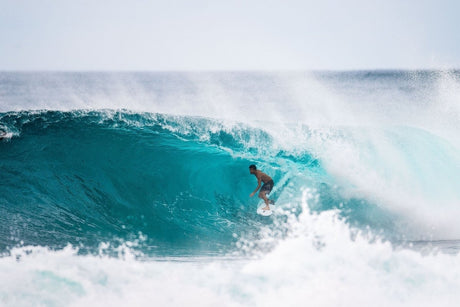The necessary equipment to start bodysurfing
One of the great advantages of bodysurfing lies in its material simplicity. However, there are a few essential items to have to ensure not only safety but also the enjoyment of riding the waves.
Bodysurfing fins
The fins are probably the first equipment you should think about. They help you gain speed and maneuverability in the water. When choosing fins, make sure they fit well and are comfortable. You don't want to lose a fin in the middle of a session! Also look for models with soft heel straps to avoid blisters during long sessions.
There are several reputable brands such as Viper or DaFin, known for their quality and performance. Choose those that best suit your swimming style and personal preferences.
Neoprene suit
Depending on the temperature of the water in which you will bodysurf, a wetsuit may be essential. In addition to providing thermal protection, it also protects against scrapes caused by sand and reefs. Wetsuits vary in thickness according to the seasons: choose a 2/2 mm for warm waters and a 4/3 mm for colder waters.
They are available from several major brands such as Rip Curl, Quiksilver, or Billabong, and offer different cuts for men and women to ensure maximum comfort.

Hand planes
Handplanes are not strictly necessary, but they can significantly enhance your bodysurfing experience. These small boards attach to your hand and allow for better control and increased speed on the wave. They also help to make your rides last longer. If you are a beginner, start with a simple model before moving on to more sophisticated versions.
You can find handplanes in various materials such as plastic, wood, or even fiberglass. Each offers a different feel, so don't hesitate to try several types to see which one suits you best.
- Increases buoyancy and speed
- Allows better control of trajectories
- Facilitate access to waves
How to train for bodysurfing
Improving in swimming
The key to success in bodysurfing lies in excellent physical condition, particularly in swimming. Spend time perfecting your freestyle and other swimming styles. This will increase your endurance and give you the ability to navigate easily among the waves. A good way to improve is to take specific swimming lessons or train regularly in a pool.
Exercises like sprint intervals followed by periods of active recovery are excellent for simulating the intense and repeated efforts of bodysurfing.
Reading the Ocean
An important part of bodysurfing is understanding the waves and ocean conditions. Take the time to carefully observe the place where you want to train. Note the direction of the currents, the size, and the frequency of the waves. This observation will sharpen your judgment to choose the best waves to surf on.
For this, mobile applications like Magicseaweed or Surfline provide detailed forecasts of waves and weather conditions. Use them to your advantage to plan your bodysurfing sessions when conditions are ideal.
Practice the technique
Surfing on waves can seem intimidating at first. It is therefore important to practice often and master the basics. The first technique to learn is the correct body positioning on the wave. Dive fully into the wave, using your leading arm and opposite hand to balance your body and steer your ride.
The transitions between swimming towards the wave and catching the wave must be smooth. Many beginners make the mistake of waiting too long before starting to glide. Be proactive and dive into the heart of the action as soon as the wave approaches.
- Work on your timing to catch the waves at the right moment
- Refine your positioning to maintain balance
- Use your legs to give powerful initial thrusts
Bodysurfing and physical preparation
In addition to technical skills, stay in shape by doing specific physical exercises. Bodysurfing engages different muscles in your body, especially those in the core and legs. Here are some exercise suggestions to strengthen these muscle groups.
Core strengthening and bodybuilding
A good core strengthening is essential for better stability and increased control over the waves. Practice core strengthening exercises daily, such as planks and obliques. These exercises strengthen the trunk, which is crucial for staying stable on a breaking wave.
Also implement strength training exercises targeting the legs and back, such as squats, lunges, and pull-ups. These exercises will increase your power and help maximize your bodysurfing performance.
Stretching and flexibility
Do not underestimate the importance of stretching in your training routine. Flexible muscles reduce the risk of injuries and generally improve your mobility. Focus on dynamic stretches before your bodysurfing sessions and static stretches afterward.
For example, yoga can be an excellent complementary practice. Not only does it improve flexibility, but it also helps strengthen the mind-body connection, which is beneficial when facing large waves.
The best spots to start bodysurfing
Choosing the right spot is crucial, especially for beginners. Look for beaches where the waves are gentle and consistent. These conditions make learning easier and provide a safe margin for error.
Fine sandy beaches
Prefer beaches with fine sandy bottoms. They are generally less dangerous and offer a good landing surface if you ever fail to catch a wave. The beaches of Biarritz or Hossegor in France are perfect examples where you can find good conditions for beginners.
Avoid rocky beaches until you are really comfortable with your technique. Rocks can be unforgiving for beginners and cause annoying injuries.
Sparsely visited spots
Start in less crowded places to avoid having to dodge other swimmers or surfers. Choosing less popular beaches means more waves for you and fewer distractions. Weekdays or early mornings are often the quietest times.
- Search for isolated beaches or coves
- Avoid very crowded surf spots
- Learn to share the space with other water sports enthusiasts
In summary, bodysurfing is an incredible adventure within reach. With the right equipment and proper preparation, you'll be ready to conquer the waves in no time. Good luck and have fun!










